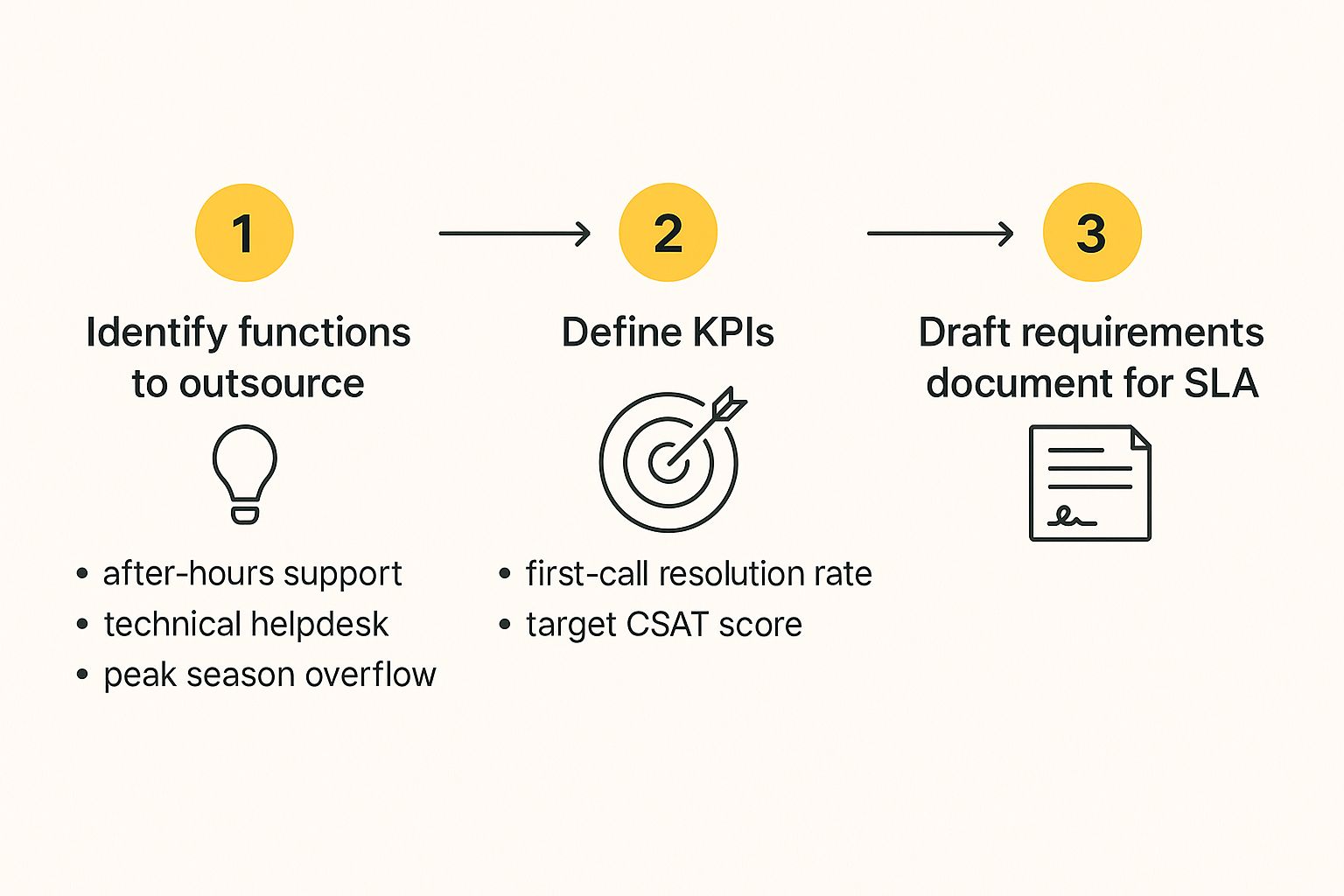For Australian businesses, the decision to outsource customer service has moved far beyond a simple cost-cutting exercise. It’s now a strategic play to tackle persistent talent shortages, crippling operational expenses, and the ever-growing demand for specialised skills and technology.
Why Australian Businesses Now Outsource Customer Service
Let's be honest, the old narrative was all about trimming the budget. But for many Aussie companies today, outsourcing customer support is a direct answer to some pretty complex challenges in our local market. Of course, the appeal of a predictable financial model is still strong, especially when you start adding up the real costs of running an in-house contact centre—recruitment, training, tech, and rent all add up fast.
But the real headache? It’s often the people.
Finding and keeping skilled customer service professionals in Australia has become a genuine struggle. This operational strain is made worse by high staff turnover, which throws a spanner in the works for team morale and service consistency.
Navigating Local Labour Challenges
The Australian contact centre industry is going through a massive shake-up, largely driven by these high operational costs and a real scarcity of talent. Right now, the attrition rate in contact centres has crept up to around 29%, with absenteeism sitting at 12.9%. That puts a huge amount of pressure on the teams you do have.
It's these exact pressures that are pushing more Australian businesses to see a customer service outsource model as the most practical way forward.
The data from IBISWorld below paints a clear picture. The business process outsourcing industry in Australia isn't just surviving; it's a massive, growing sector.

This growth isn't just a number on a chart. It shows a real trend: companies are actively looking for external partners to solve core operational problems that have become too difficult and expensive to manage on their own.
A Strategic Shift to Specialised Skills
Modern customer service is so much more than just answering the phone. To do it well, you need genuine expertise in some pretty technical areas:
- Advanced AI and Automation: Someone who can actually implement and manage chatbots, AI-powered analytics, and automated workflows that genuinely improve efficiency.
- Omnichannel Support: The ability to deliver a seamless, consistent experience whether a customer reaches out via email, chat, social media, or a phone call.
- Data Security and Compliance: A deep understanding of Australian privacy laws and the robust systems needed to protect sensitive customer information.
By outsourcing, businesses get instant access to these specialised skills and advanced technologies. It cuts out the need for massive upfront investment in training and infrastructure. You’re essentially shifting from a reactive support model to a proactive, experience-focused one.
This strategic move is a game-changer for industries like e-commerce, where customer expectations are through the roof. For a closer look at what's driving this in that space, check out the Top Reasons to Outsource Ecommerce Customer Service.
Ultimately, outsourcing becomes a way to build operational flexibility and create a resilient support system that can scale up or down with demand—a feat that's often just too resource-intensive to pull off from scratch.
Defining What Success Looks Like for You
Before you even think about looking for partners, the most crucial step is to look inward. A solid customer service outsource strategy starts with a crystal-clear understanding of what you actually need and, just as importantly, what a "win" looks like for your business.
Jumping into vendor calls without this internal clarity is like going grocery shopping without a list—you'll end up with things you don't need and completely forget the essentials.
Start by pinpointing the exact functions you want to hand over. It’s rarely an all-or-nothing decision. For some businesses, it might mean finding a team to handle after-hours support so your local crew can finally switch off. For others, it’s about sourcing a specialised technical helpdesk or simply managing call overflow during the Christmas rush.
Setting Meaningful Performance Goals
Once you know what you’re outsourcing, you need to define how you’ll measure success. This means setting meaningful Key Performance Indicators (KPIs) right from the get-go. These aren’t just numbers on a spreadsheet; they are the benchmarks that will tell you if your investment is actually paying off.
You'll want to get specific with metrics like:
- First-Call Resolution (FCR) Rate: What percentage of customer issues should be solved in a single interaction? A high FCR, say 80% or more, is a great target because it cuts down on customer frustration and your operational costs.
- Customer Satisfaction (CSAT) Score: Set a clear goal for customer happiness. A good starting point is aiming to maintain an average CSAT score of 4.5 out of 5.
- Average Response Time: How quickly should your partner respond? Nail this down for each channel. Maybe it's under 60 seconds for live chat or within four hours for email.
This initial spadework—identifying functions and setting clear KPIs—is the absolute foundation of a successful partnership. The infographic below breaks down this vital planning phase.

As you can see, this structured approach helps you move from vague ideas to a concrete, actionable plan. It’s the straightest path to creating a requirements document that will guide your entire search.
Creating Your Requirements Document
Think of this document as your blueprint. It’s what you’ll share with potential vendors to get accurate quotes and what will eventually form the basis of your Service Level Agreement (SLA). Don't hold back on the details here—the more specific you are, the better the outcome will be.
Your requirements document should be a living guide for your potential partner. It needs to clearly outline your brand's voice, your core values, and the non-negotiable standards of customer interaction you expect. It's not just about tasks; it's about representing your brand correctly.
This document is what bridges the gap between your internal goals and a vendor’s day-to-day operations. A well-defined set of requirements ensures everyone is on the same page from the beginning, preventing nasty surprises down the track and setting your partnership up for success.
Honestly, it’s the single most effective tool you have for finding a provider who doesn’t just perform tasks, but truly gets what your business is all about.
Finding the Right Customer Service Outsource Partner

Choosing a partner is the single most important decision you'll make in your outsourcing journey. Get it right, and you’ll gain a powerful extension of your team. Get it wrong, and you’re left managing customer complaints and brand damage.
The goal here isn't just to find a service provider who ticks a few boxes—it's to find a true partner.
The good news is that Australian businesses have a massive amount of choice. The business process outsourcing (BPO) market is extensive, with over 35,500 businesses operating in the country. This means you can find everything from small, niche firms that specialise in your industry to the big global players.
But with all that choice comes the need to be extra diligent. It’s time to dig deep.
Beyond the Sales Pitch
Every potential partner will present a polished case study and promise you the world. Your job is to look behind the curtain and find out what’s really going on. Start by asking pointed questions about the things that actually affect customer experience.
- Agent Training and Development: How do they train their agents on new products or complex issues? Ask to see their training materials and ongoing development plans. Don't settle for vague answers.
- Quality Assurance (QA) Process: What does their QA framework look like? Do they just score calls, or do they provide structured coaching and genuine feedback to agents to help them improve?
- Technology Stack: What platforms do they use? You need to be sure their systems can integrate smoothly with your CRM and other essential tools without causing a headache.
These questions reveal a partner's real commitment to quality, not just hitting basic service levels. A great customer service outsource partner invests heavily in their people and processes because they know it's your customers on the line.
Checking for Cultural and Legal Alignment
True alignment goes far beyond a similar time zone. You need a partner whose team can genuinely represent your brand's voice and values. If your brand is informal and friendly, a provider with a rigid, scripted approach will feel jarring to your customers.
A partner’s culture inevitably becomes part of your customer's experience. During your evaluation, listen carefully to how they talk about their own team and their clients. This will tell you more about their values than any mission statement on their website.
Just as important is their approach to data security. Ask specific, detailed questions about how they handle sensitive customer information and make sure they are fully compliant with Australian privacy laws. This is completely non-negotiable. For many businesses, a modern phone solution is part of this puzzle; you can learn more about how a professional business answering service handles this securely.
To help structure your thinking and compare apples with apples, a simple checklist can be a lifesaver. It forces you to be objective when you're being wowed by a slick sales presentation.
Vendor Evaluation Checklist
| Evaluation Criteria | Vendor A | Vendor B | Vendor C | Notes |
|---|---|---|---|---|
| Industry Specialisation | Does their experience match our sector? | |||
| Agent Training Program | How comprehensive is it? Ask for examples. | |||
| QA & Coaching Process | Is feedback constructive and regular? | |||
| Technology Integration | Can their stack connect to our CRM/tools? | |||
| Data Security Compliance | Do they meet AU privacy standards? | |||
| Cultural Fit & Brand Voice | Do they 'get' our brand? | |||
| Scalability Options | Can they grow with us? | |||
| Client References | Are their clients similar to us? | |||
| Pricing Structure | Is it transparent and fair? |
Finally, do your own homework. Ask for references from current clients who are similar to your business in size and industry. Don't be afraid to conduct a site visit—either in person or virtually—to get a real feel for their operational environment. Seeing the team in action is often the best way to determine if they are the right fit to become the voice of your brand.
How to Manage a Smooth Transition

Choosing your customer service outsource partner is a massive milestone, but it's really just the starting line. Now the real work of integration begins.
A successful handover doesn’t just happen. It needs a deliberate, collaborative plan to make sure your customer experience doesn't skip a beat. The goal here is to make the new team feel like a genuine extension of your own, not just a disconnected service provider.
The first step? Arm them with the right tools. And the most powerful tool of all is knowledge. You can't expect an outsourced team to represent your brand if they don't understand it inside and out.
Building a Bulletproof Knowledge Base
Your new partner needs more than just a product manual. They need a comprehensive knowledge base that becomes their single source of truth for every possible customer interaction. This isn't just about dumping a bunch of documents on them; it should be a well-organised, searchable resource they can actually use.
Make sure it includes things like:
- Detailed Product Information: Don't just list features. Explain why those features matter to your customers and the problems they solve.
- Frequently Asked Questions (FAQs): Go beyond the obvious. Include the tricky, nuanced questions your in-house team handles every single day.
- Brand Voice and Tone Guidelines: Show, don't just tell. Provide clear examples of how you want your brand to sound. Are you empathetic and professional, or a bit more playful and casual?
A solid knowledge base empowers the outsourced team to solve problems on their own, with confidence. It drastically cuts down on those "let me ask my manager" moments that frustrate customers and ensures every agent speaks with one consistent, authentic brand voice.
This foundation is crucial, but it's only half the battle. Next, you need to bring that knowledge to life with hands-on training and seamless tech integration.
Designing a Joint Training Program
Don't just hand over your knowledge base and cross your fingers. A joint training program is essential to really immerse the outsourced team in your company's culture and values. This has to be a collaborative effort, blending your partner's training expertise with your deep brand knowledge.
For example, a software company could run mock technical support calls with the new team, throwing real-world problems their way. This kind of hands-on practice is far more effective than just reading a manual. It's also a great way to build rapport between your internal experts and their new external counterparts.
The technical setup needs just as much attention. This means setting up secure access to your core systems, like your Customer Relationship Management (CRM) platform and support ticketing software. If you use specific communication tools, ensuring your partner can integrate with your existing setup—like an automated phone answering system—is vital for a smooth workflow.
Ultimately, a smooth transition comes down to treating it like any other critical business project. You need clear communication channels, realistic timelines, and collaborative project management tools to keep everyone on the same page. Open dialogue and a shared purpose will prevent any dips in service quality and set the stage for a lasting, successful partnership.
Building a Partnership That Lasts
Signing on the dotted line with your new customer service partner isn't the finish line; it’s the very beginning of a relationship. The real success of this whole venture hinges on how you treat that partnership from day one. It’s all about communication, feedback, and working towards the same goals.
If you just hand over the keys and expect everything to run perfectly, you’re setting yourself up for disappointment. The trick is to treat the outsourced team as a genuine extension of your own. And that starts with being open and honest about performance.
Tracking Performance Beyond the Numbers
While those Key Performance Indicators (KPIs) you agonised over are important, they don’t paint the whole picture. A truly strong partnership is built on check-ins that dig deeper than just hitting targets. Shared dashboards are brilliant for keeping a real-time pulse on metrics like First-Call Resolution and Customer Satisfaction (CSAT) scores.
But the real magic happens in those regular, honest performance reviews. Get on a weekly or fortnightly call to actually talk about the data. If CSAT scores take a dip, don't just point fingers—get in the trenches with them to figure out why. It could be something as simple as a gap in the knowledge base, or maybe an issue with a new product that only they, on the front lines, would notice.
These conversations are your chance to solve problems together and find new ways to make things even better.
A partnership isn't just about accountability; it's about shared ownership of the customer experience. When your outsourced team feels heard and valued, they become proactive problem-solvers for your brand.
Creating a Truly Integrated Team
Making an external team feel like they’re part of the crew is absolutely critical for keeping standards high and morale even higher. This goes way beyond a one-off joint training session. It’s about consistently bringing them into the fold.
- Share All Customer Feedback: Don’t just be the bearer of bad news. When a customer leaves a glowing review, make sure the team sees it. Let them know the positive impact they're having.
- Celebrate Wins Together: Did the team hit a record-high CSAT score? Make a big deal out of it! Acknowledging their hard work is a massive motivator and builds loyalty.
- Collaborate on Process Improvements: Your outsourced agents are a goldmine of information. If they suggest a small tweak to a workflow that could save time or headaches, listen up. It shows you respect their expertise.
By building this deep connection, you shift from a basic client-vendor setup to a powerful, unified team. It’s this collaborative spirit that ensures your customer experience is always getting better, driven by people who are genuinely invested in your brand's success. As you think about different ways to integrate external help, understanding the nuances of how a virtual receptionist fits in can offer great insight into potential cost benefits. You can learn more in our guide on virtual receptionist cost.
Common Questions About Outsourcing Customer Service
Deciding to outsource customer service is a massive step, and it’s only natural for a heap of questions to pop up. Getting straight answers is the only way you’ll feel confident enough to pull the trigger. So, let's get into some of the most common worries business owners have when they head down this path.
One of the biggest anxieties I hear about is control. Will you lose that direct connection with your customers? Is the quality going to take a nosedive? These are completely valid fears, but they’re nothing a good partner and a solid communication plan can't handle.
Then there's the brand itself. How can an outside team ever really get your unique voice and values? It's a fair question. The answer lies in a rock-solid onboarding process and a brand guide that leaves nothing to chance.
How Do I Ensure Data Security?
Let's be blunt: when you talk about outsourcing, data security isn't just a talking point—it's everything. You're responsible for protecting your customers' sensitive information, and you need to be dead certain your partner is up to scratch with Australia's strict privacy standards.
When you're vetting potential providers, don't be shy. Ask them to walk you through their security protocols in detail. This means digging into their data encryption methods, the physical security of their facilities, and even how they vet their own staff. A partner worth their salt will have this all documented and be more than happy to show you.
At the end of the day, your customer data is still your responsibility. Make sure your contract has iron-clad data protection clauses and clearly spells out who is liable for what. This gives you both legal and operational peace of mind. Your partner’s commitment to security has to be as strong as your own.
Taking this proactive approach means you’re not just crossing your fingers; you’re actively protecting your business and your customers from any potential risks.
Will We Lose Our Brand Voice?
Holding onto your brand's unique personality is right up there with data security as a major concern. Your customers know your style, and a sudden change can feel really jarring. The trick is to stop thinking of your outsourced team as a vendor and start treating them like an extension of your own crew.
It all starts with giving them a comprehensive brand book that covers the essentials:
- Tone of Voice: Are you formal and professional? Or more casual and witty? Give them clear examples of what good (and bad) looks like.
- Approved Language: List out specific phrases you love and, just as importantly, any words or terms that are completely off-limits.
- Customer Personas: You need to help them understand exactly who they're talking to. What makes your customers tick?
Many businesses also look at integrating AI Chatbots into their customer service strategy. An outsourcing partner can manage these effectively, making sure even the automated chats stick to your brand's tone. Consistent training and regular feedback sessions are non-negotiable to keep everyone on the same page. By putting in the effort here, you make sure every single customer interaction feels genuinely you.
Ready to streamline your calls and focus on what matters most? OnSilent provides a smart AI Call Assistant that filters spam, organises messages, and saves you hours every week. Discover a better way to manage your communications at https://onsilent.com.

